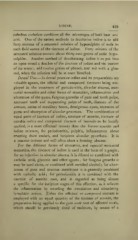Page 441 - My FlipBook
P. 441
IODINE. 439
colorless carbolate combines all the advantages of both base and
acid. One of the easiest methods to decolorize iodine is to add
forty minims of a saturated solution of hyposulphite of soda to
each fluid ounce of the tincture of iodine. Forty minims of the
saturated solution contain about thirty-two grains of sodic hypo-
sulphite. Another method of decolorizing iodine is to put into
an open vessel a drachm of the tincture of iodine and six ounces
of hot water ; add twelve grains of phenol, and stir with a glass
rod, when the solution will be at once bleached.
Dental Uses.—In dental practice iodine and its preparations are
valuable agents, the official and compound tinctures being em-
ployed in the treatment of periodontitis, alveolar abscess, mer-
curial stomatitis and other forms of stomatitis, inflammation and
ulceration of the gums, fungous growths of gum and tooth pulps,
necrosed teeth and suppurating pulps of teeth, diseases of the
antrum, caries of maxillary bones, dentigerous cysts, recession of
gums and absorption of alveolar processes. The combination of
equal parts of tincture of iodine, tincture of aconite, tincture of
canabis indica and compound tincture of benzoin to be locally
applied, is a more effectual remedy than the former aconite and
iodine mixture, for periodontitis, pulpitis, inflammation about
erupting third molars, and incipient alveolar pyorrhoea. It is
a counter-irritant and will often abort a forming abscess.
For the different forms of stomatitis, and especial mercurial
stomatitis, the tincture of iodine is used in the form of a gargle;
for an injection in alveolar abscess it is diluted or combined with
for fungous growths
carbolic acid, glycerin and other agents ; it
may be used alone, or combined with rectified alcohol ; for ulcer-
ations of gum and mucous membrane it is generally combined
with carbolic acid ; for periodontitis it is combined with the
tincture of aconite root, and is regarded as being almost
a specific for the incipient stages of this affection, as it relieves
the inflammation by retarding the circulation and stimulating
lymphatic action. Either the officinal or compound tincture is
employed with an equal quantity of the tincture of aconite, the
preparation being applied to the gum over root of affected tooth,
which should be previously dried of moisture, by means of a


